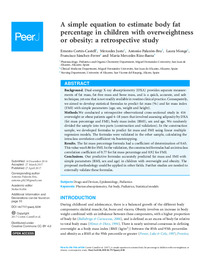Por favor, use este identificador para citar o enlazar este ítem:
https://hdl.handle.net/11000/30685Registro completo de metadatos
| Campo DC | Valor | Lengua/Idioma |
|---|---|---|
| dc.contributor.author | CORTÉS CASTELL, ERNESTO | - |
| dc.contributor.author | Mercedes, Juste | - |
| dc.contributor.author | Palazón-Bru, Antonio | - |
| dc.contributor.author | Monge, Laura | - |
| dc.contributor.author | Rizo-Baeza, María Mercedes | - |
| dc.contributor.author | Sánchez-Ferrer, Francisco | - |
| dc.contributor.other | Departamentos de la UMH::Farmacología, Pediatría y Química Orgánica | es_ES |
| dc.date.accessioned | 2024-01-26T09:57:31Z | - |
| dc.date.available | 2024-01-26T09:57:31Z | - |
| dc.date.created | 2017-04 | - |
| dc.identifier.citation | PeerJ .2017. Vol.5 | es_ES |
| dc.identifier.issn | 2167-8359 | - |
| dc.identifier.uri | https://hdl.handle.net/11000/30685 | - |
| dc.description.abstract | Background. Dual-energy X-ray absorptiometry (DXA) provides separate measurements of fat mass, fat-free mass and bone mass, and is a quick, accurate, and safe technique, yet one that is not readily available in routine clinical practice. Consequently, we aimed to develop statistical formulas to predict fat mass (%) and fat mass index (FMI) with simple parameters (age, sex, weight and height). Methods.We conducted a retrospective observational cross-sectional study in 416 overweight or obese patients aged 4–18 years that involved assessing adiposity by DXA (fat mass percentage and FMI), body mass index (BMI), sex and age. We randomly divided the sample into two parts (construction and validation). In the construction sample, we developed formulas to predict fat mass and FMI using linear multiple regression models. The formulas were validated in the other sample, calculating the intraclass correlation coefficient via bootstrapping. Results. The fat mass percentage formula had a coefficient of determination of 0.65. This value was 0.86 for FMI. In the validation, the constructed formulas had an intraclass correlation coefficient of 0.77 for fat mass percentage and 0.92 for FMI. Conclusions. Our predictive formulas accurately predicted fat mass and FMI with simple parameters (BMI, sex and age) in children with overweight and obesity. The proposed methodology could be applied in other fields. Further studies are needed to externally validate these formulas. | es_ES |
| dc.format | application/pdf | es_ES |
| dc.format.extent | 14 | es_ES |
| dc.language.iso | eng | es_ES |
| dc.publisher | PeerJ Inc. | es_ES |
| dc.rights | info:eu-repo/semantics/openAccess | es_ES |
| dc.rights.uri | http://creativecommons.org/licenses/by-nc-nd/4.0/ | * |
| dc.subject | Photon absorptiometry | es_ES |
| dc.subject | Fat body | es_ES |
| dc.subject | Pediatrics | es_ES |
| dc.subject | Statistical models | es_ES |
| dc.subject.other | CDU::6 - Ciencias aplicadas::61 - Medicina::616 - Patología. Medicina clínica. Oncología | es_ES |
| dc.title | A simple equation to estimate body fat percentage in children with overweightness or obesity: a retrospective study | es_ES |
| dc.type | info:eu-repo/semantics/article | es_ES |
| dc.relation.publisherversion | https://doi.org/10.7717/peerj.3238 | es_ES |

Ver/Abrir:
Peer J Equación obesidad.pdf
447,88 kB
Adobe PDF
Compartir:
 La licencia se describe como: Atribución-NonComercial-NoDerivada 4.0 Internacional.
La licencia se describe como: Atribución-NonComercial-NoDerivada 4.0 Internacional.
.png)